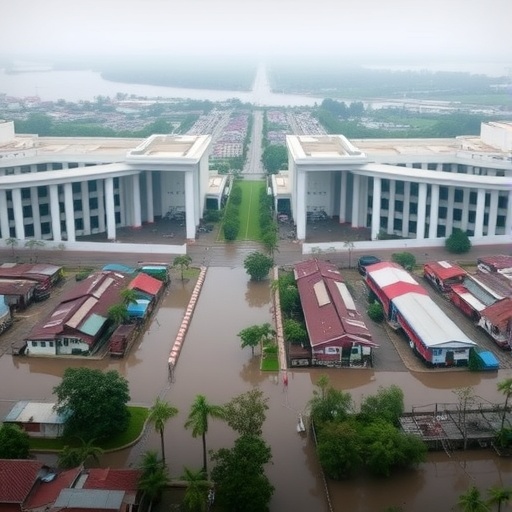In recent years, the intersection of social inequality and climate vulnerability has emerged as a critical area of scientific inquiry, particularly as cities around the globe grapple with the increasing frequency and intensity of natural disasters. A groundbreaking study published in Nature Cities advances this discourse by offering an unprecedented assessment of flood exposure across 44,698 urban neighborhoods throughout Latin America. The research, spearheaded by Kephart, Bilal, Gouveia, and colleagues, sheds light on the intricate tapestry of social disparities that underpin urban flood risk, revealing how marginalized communities disproportionately bear the brunt of hydrological hazards.
Urban flooding, propelled by climate change-driven extreme precipitation events, rapid urbanization, and often inadequate infrastructure, remains a persistent threat to public safety, urban economy, and sustainable development. Latin America, with its unique urban morphology characterized by pronounced socio-spatial segregation, presents a particularly revealing context to examine how flood exposure correlates with socio-economic indicators. The study leverages high-resolution spatial data combined with social demographic variables to parse these complex interdependencies with remarkable granularity.
Central to the findings is the revelation that neighborhoods with lower socio-economic status face significantly higher flood exposure compared to their wealthier counterparts. This pattern was consistent across the 44,698 neighborhoods analyzed, underscoring systemic vulnerabilities shaped by historic patterns of urban planning, marginalization, and resource allocation. The authors articulate that these inequities are not coincidental but rather the outcome of entrenched structural forces that dictate where and how people live within Latin American metropolises.
Methodologically, the study employs advanced geospatial analytics, integrating satellite-derived flood hazard maps with census-level socio-economic data, such as income brackets, housing quality, and access to urban services. This multidimensional approach illuminates disparities at the micro-urban scale, enabling a nuanced understanding of exposure risks often masked in coarser analyses. The data fusion techniques underpinning this work reflect the cutting edge of urban environmental science, blending remote sensing technology with social science methodologies.
Moreover, the study delves into the policy implications of these findings. Recognizing that flood mitigation measures tend to be inequitably distributed, the authors advocate for targeted interventions that prioritize the most vulnerable neighborhoods. This includes investments in green infrastructure, improved drainage systems, and urban planning that accounts for socio-economic vulnerabilities. The research suggests that flood resilience efforts lacking an equity lens risk perpetuating or exacerbating existing disparities.
Another significant contribution of this research is its demonstration of the scalability and replicability of its analytical framework. By applying the methodology across a vast number of neighborhoods in multiple countries, the study provides a template for other urban regions facing similar challenges. The implications extend beyond Latin America, presenting an adaptable model for assessing and addressing climate vulnerability in socio-economically stratified urban landscapes worldwide.
The paper also tackles the relationship between informal settlements and flood risk. Informal housing, often situated in ecologically precarious zones like floodplains or steep slopes, exhibits elevated exposure levels. This spatial alignment of poverty and hazard underscores the urgent need for integrative urban policies that couple social development with environmental risk reduction. The study’s spatial data clearly illustrates how informal urbanization processes compound flood hazards, demanding nuanced governance and inclusive planning.
Importantly, the research incorporates temporal dimensions by analyzing flood exposure changes over time. This time-series approach reveals that while some neighborhoods have seen improvements through infrastructural upgrades or policy interventions, others continue to experience stagnant or worsening exposure. Such dynamic analysis is vital for understanding the trajectories of environmental justice in urban contexts, highlighting where progressive change occurs and where further action is requisite.
The authors also explore the intersectionality of flood exposure, noting how vulnerabilities magnify when multiple socio-demographic risk factors combine. For instance, neighborhoods with high poverty rates, low educational attainment, and limited access to social services experience compounded risk, amplifying the detrimental effects of flooding beyond physical damage to include health, economic stability, and social cohesion impacts.
Technical details in the study highlight the use of machine learning algorithms to classify neighborhoods based on exposure indices. This approach enhances predictive capabilities to identify at-risk communities with high confidence. By employing supervised learning techniques trained on ground-truth flood event data, the researchers improve the reliability of exposure assessments, which is critical for informed decision-making in urban resilience planning.
The study situates its findings within the broader theoretical framework of environmental justice, articulating how flood risk exemplifies uneven burdens borne by marginalized populations. Drawing on interdisciplinary scholarship, the paper contextualizes flood exposure as both a consequence and driver of social inequality, suggesting that efforts to tackle urban flood risk must be integrative and equity-focused.
The implications for public health emerge as another focal point. Flooding in vulnerable neighborhoods correlates with increased incidences of waterborne diseases, mental health challenges, and displacement-related stressors. The research warns that neglecting social disparities in flood exposure could exacerbate urban health inequities, particularly in rapidly urbanizing centers with limited health infrastructure.
From a technological standpoint, the study signals advancements in urban analytics by harnessing big data platforms and cloud computing for data processing at unparalleled scales. Such innovations democratize access to high-fidelity urban risk data, enabling local governments and civil society to participate more effectively in disaster risk reduction dialogues and actions.
The researchers conclude by urging a paradigm shift in urban climate adaptation strategies towards ones that are explicitly equity-centered. They emphasize collaboration across government sectors, community stakeholders, and international organizations to implement multifaceted solutions that address both environmental hazards and social determinants of vulnerability.
In sum, the study by Kephart et al. stands as a landmark contribution to understanding how social disparities shape urban flood exposures across Latin America. Its technical rigor, expansive dataset, and policy-relevant insights provide a vital roadmap for crafting cities that are not only resilient to climate impacts but also more just and inclusive. As climate change accelerates, addressing the social dimensions of environmental risk will be paramount in safeguarding urban futures.
Subject of Research: Social disparities in urban flood exposure across Latin American neighborhoods.
Article Title: Social disparities in neighborhood flood exposure in 44,698 urban neighborhoods in Latin America.
Article References:
Kephart, J.L., Bilal, U., Gouveia, N. et al. Social disparities in neighborhood flood exposure in 44,698 urban neighborhoods in Latin America. Nat Cities 2, 246–253 (2025). https://doi.org/10.1038/s44284-025-00203-3
Image Credits: AI Generated
DOI: https://doi.org/10.1038/s44284-025-00203-3
Tags: climate justice and urban developmentflood risk assessment in Latin Americahigh-resolution spatial data analysisinfrastructure inadequacies and floodingmarginalized communities and flood exposurepublic safety and sustainable developmentsocial inequality and climate vulnerabilitysocio-economic disparities in flood risksocio-spatial segregation in citiessystemic vulnerabilities in urban neighborhoodsurban flooding and climate changeurbanization and natural disasters






